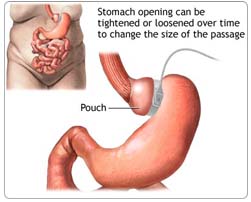Restrictive gastric operations, such as an adjustable gastric banding procedure, serve only to restrict and decrease food intake and do not interfere with the normal digestive process.
The Procedure
In this procedure, a hollow band made of special material is placed around the stomach near its upper end, creating the small pouch and a narrow passage into the larger remaining portion of the stomach. This small passage delays the emptying of food from the pouch and causes a feeling of fullness.
The band can be tightened or loosened over time to change the size of the passage. Initially, the pouch holds about 1 ounce of food and later expands to 2-3 ounces.
 In this procedure, commonly known as the LapBandR, a silicone elastomer band is placed around the upper part of the stomach to create a small stomach pouch which can hold only a small amount of food. The lower, larger part of the stomach is below the band. These two parts are connected by a small outlet created by the band. Food will pass through the outlet ("stoma" in medical terms) from the upper stomach pouch to the lower part more slowly, and one will feel full longer. The diameter of the band outlet is adjustable to meet individual needs, which can change as one loses weight.
In this procedure, commonly known as the LapBandR, a silicone elastomer band is placed around the upper part of the stomach to create a small stomach pouch which can hold only a small amount of food. The lower, larger part of the stomach is below the band. These two parts are connected by a small outlet created by the band. Food will pass through the outlet ("stoma" in medical terms) from the upper stomach pouch to the lower part more slowly, and one will feel full longer. The diameter of the band outlet is adjustable to meet individual needs, which can change as one loses weight.
Adjustable Gastric Banding - Advantages & Disadvantages
AGB Advantages
- Simple and relatively safe
- Short recovery period
- Major complication rate is low
- No opening or removal of any part of the stomach or intestines
- No altering of the natural anatomy
- Very short recovery periods
AGB Disadvantages
- About 5 percent failure rate because of:
- Balloon leakage
- Band erosion/migration
- Deep infection
- Identifying patients who will not "eat through" the operation is difficult.
Although restrictive operations lead to weight loss in almost all patients, they are less successful than malabsorptive operations in achieving substantial, long-term weight loss. Successful results depend on the patient's willingness to adopt a long-term plan of healthy eating and regular physical activity.





